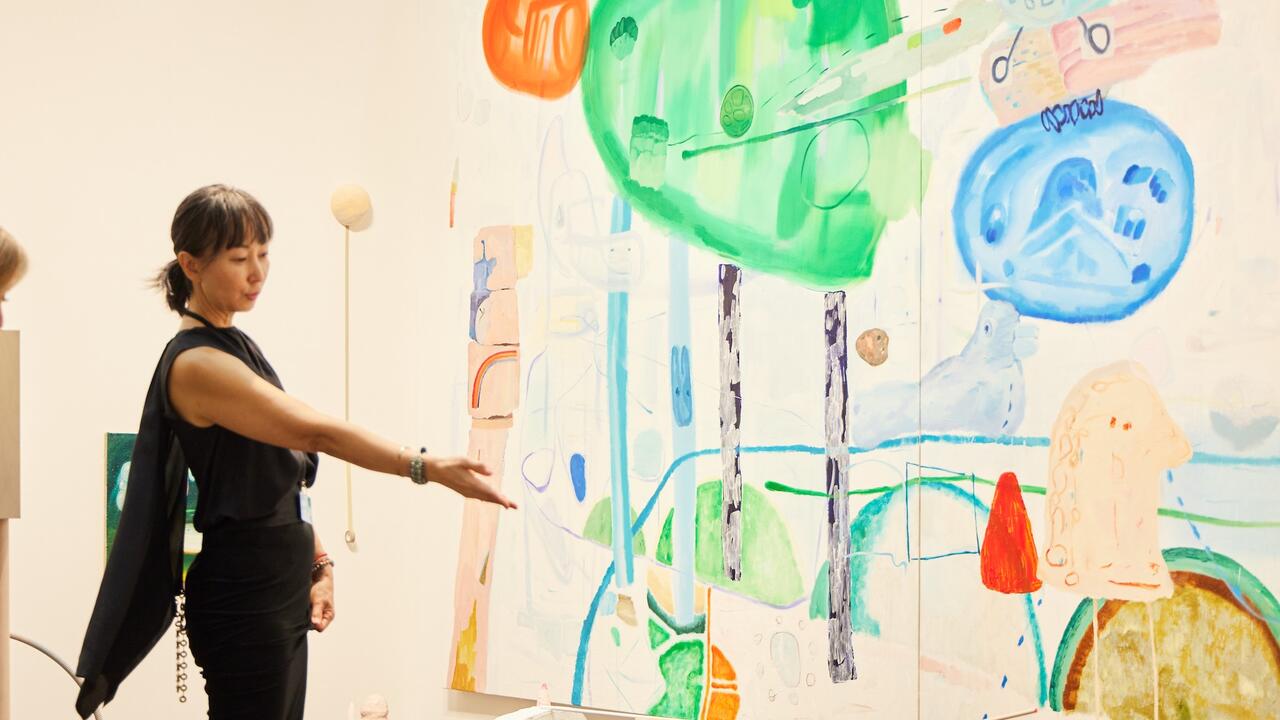Richard T. Walker

Richard T. Walker’s sumptuous, high-definition video projections all begin with an archetypical vignette: a solitary Caspar David Friedrich-style man walks to the centre-foreground of a fixed widescreen shot, turns his back to the viewer and scans the mountainous distance. The figure is, of course, Walker himself. Celebrating and joyfully confusing pictorial codes of Romantic and Land art, his quixotic evocation of the sublime commune between Man and Nature is knowing, but neither arch nor ironic. Born in the UK and now based in San Francisco, the artist’s encounters with the American landscape are wistful and witty, idiosyncratic and awestruck.
In the two-screen projection the speed and eagerness of meaning (2011), Walker scrabbles across a patch of desert-wilderness carrying an old-fashioned tape-recorder. He presses play, and a voice is heard reading a text (written by Walker) that mulls over the notion that the landscape is drenched in language and pre-established meaning: it is an ‘inviting cushion for words to stretch and lie down upon’. Walker is next shown brandishing a selection of musical instruments – a guitar, a banjo, a drum, a keyboard – and (with not a little post-production editing) serenades the landscape with a soaring, folksy tune. Like a jilted lover on a last-ditch attempt to win over an obdurate mistress, he is doomed to a noble sort of failure. Try as we might, the landscape doesn’t love us back.
Walker’s exhibition at Carroll / Fletcher also emphasized his engagement with sound, music, sculpture, photography and text. For example, in defiance of being here (2013) is an endearing-if-gimmicky floor-piece consisting of two keyboards with a key on each depressed by a small stone, a couple of tape-recorders and three neon works shaped like the outline of mountaintops. A single chord emanates from the tape recorders: a synth-drone evocative of Popol Vuh’s soundtracks for Werner Herzog’s early films. In the next space was ‘proximity of longing’ (2013), a series of 27 nearly identical photographs of a desert landscape at sundown with an analogue slide-carrousel set up on a tripod and a projection screen nearby. The only difference between each photograph is the image on the screen: a series of text-based phrases (‘I have become too familiar with these places’) written in a confessional, first-person mode.
This self-mocking plaintive quality might align Walker with that wider tendency defined by Jörg Heiser (co-editor of frieze) as ‘romantic conceptualism’ – or what I would prefer to call in this instance the ‘slapstick conceptualism’ of artists such as Bas Jan Ader, Bruce McLean and Keith Arnatt. There is undoubtedly a long history of artists engaging with, and undermining, the portentousness of certain strands of Land art (McLean’s 1970 film The Elusive Sculptor, Richard Long, in which he walks through a London park asking people if they have seen ‘a man out walking’, should certainly be better known). While Walker is no pioneer in his jocose approach to the sublime, what does seem new is the use of music to re-energize this engagement. This is post-MTV, post-YouTube Land art, if you will – a hybrid form also explored by Ragnar Kjartansson and Guido van der Werve. (Indeed, most of Walker’s films are only marginally longer than your standard music video). In let this be us (2012), for example, Walker hums a melody, strums a guitar and plays a keyboard in the wilderness. In each shot, part of his body (head or torso) is hidden behind a photographic print of the same landscape, which is held aloft with tripod stands so the horizon in the image seamlessly matches that of the real landscape. Shot in a number of locations,
the work is edited together afterwards into a slick, high-definition musical ode to the scenery.
Walker’s music is an offshoot of folk mixed with a distinctly modern electro-synth drone. I’m ambivalent about much prefix-heavy forms of recent folk music (the inflated escapism of freak-folk, the chintzy vapours of Sufjan Stevens et al). Thankfully, Walker’s final video here, outside of all things (2013), deploys these sounds to a rousing dénouement: series of shots of a scrubby desert accompany a soundtrack based around a repeated phrase that sounds something like the Islamic call to prayer mixed with the sonic wash of a distant rainstorm. On screen, Walker strides across the landscape with an image of a snow-capped peak strapped to his back. As the sun starts to set, the soundtrack changes to a programmed drumbeat and, as a coda, he plays a thumping tune to the landscape on a keyboard and a battery-powered amplifier. This set-up is rigged to a couple of neon strips in the shape of the outlines of two mountaintops, which blink in time to the music: a disco for the wilderness. The scene seems inexplicable, redolent of some form of communion beyond verbal or textual cognition.
















